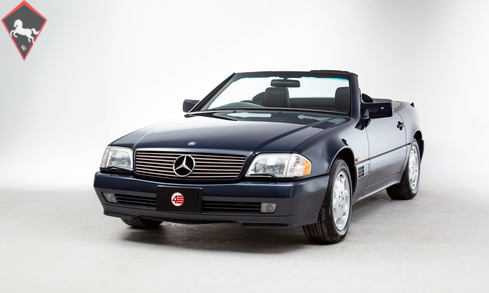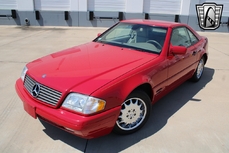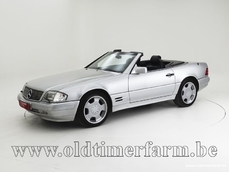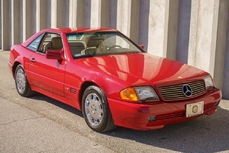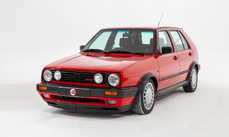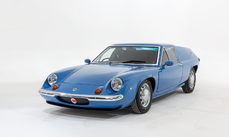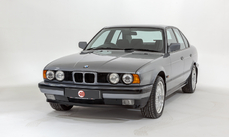Mercedes-Benz 500SL r129 SL500 1995
General description :
Model History
Designed and built as a grand tourer the SL was first introduced in 1954. The designation SL derives from the German for ‘Sport Lightweight' and was first applied to the 300 SL Gullwing. The SL model range is still in production today and has spanned five generations of models from 1954 to the present day.
The R129 as featured here is the fourth generation of car and was built from 1989-2002. Featuring a shorter wheelbase and updated rear suspension over its predecessor the R107. The R129 was quick to introduce model updates and featured a large amount of styling, mechanical and technological updates over its 12-year life span.
This generation of SL shot to the public's attention in 1991 when Diana, Princess of Wales, sold her Jaguar to purchase a 500SL. This sparked a media storm, as this was the first time a member of the royal family had chosen a foreign car. The media questioned whether British royalty should be driving foreign cars and eventually due to pressure she was forced to return the car to Mercedes-Benz in 1992. The car now features in the Mercedes-Benz Museum.
Equipment
Midnight Blue paintwork (904), Black perforated leather interior (271), Electric front seats with memory function (241/242), Sports steering wheel and leather gearshift (281), Automatic climate control (581), Green heat-insulating glass with heated rear window (592), Headlamp wash/wipe (600), 8-hole alloy wheels (652), Electric folding soft-top in black (740), Model year 1995 (805), Bose sound system (810), Mercedes CD-changer, Cassette holder, Heated front seats (873), Lock system with infrared remote control (880), Alloy spare wheel, Mercedes first aid kit, Warning triangle.
Exterior
This low mileage SL is finished in the single tone colour scheme of Midnight Blue. The bodywork presents with a deep lustre and remains entirely scrape-free all round. There are no unsightly swirls in the paint and almost no stone chips to the front end. The Midnight Blue hardtop is in equally pristine condition and the black folding soft-top is unmarked, with no damage to the rear window. Having previously resided in a dry climate this fantastic example boasts an entirely corrosion-free body and underside.
Interior
The SL’s well-appointed cabin boasts unmarked black leather and pristine walnut trim. The interior is just as you would expect for 30k miles; there is no sun damage or cracking to either the dash or glossy wood veneers, and the upholstery presents with almost no signs of any wear. The carpets are also spotless.Pleasingly all of the switchgear remains feeling solid to operate and works just as it should. Still equipped with its factory Mercedes radio, this example also features a handy cassette holder in the centre console and a Mercedes CD changer in the boot. The upgraded Bose sound system comprises of seven high-performance speakers including a bass module behind the passenger seat.
ENGINE & TRANSMISSION
The Mercedes-Benz 5-litre V8 produces a healthy 323hp. The engine bay is particularly clean and tidy, with absolutely no signs of any corrosion or poor repair to be found. On close inspection you’ll notice factory-applied protective wax still present on some of the components. The car was most recently serviced at 30k miles.
WHEELS, TYRES & BRAKES
The SL sits on its original 8-hole alloys, which are shod in a matching set of Bridgestone tyres. The wheels are all in fine original condition, with only a couple of very discreet curb marks to note. The tyres have at least 5mm of tread remaining and the brakes still do a great job of pulling the car to a stop quickly and in a straight line.
History File
This R129 was first registered in July 1995 and was supplied new by Yanase Mercedes-Benz in Japan. Accompanying the paperwork is the original Mercedes leather document holder complete with all dealer-supplied manuals and the service booklet. A data sheet from Mercedes-Benz confirms the exact build specification and date of manufacture. The car is now fully UK registered with all import taxes having been paid on arrival.
http://www.4starclassics.com/for-sale/mercedes-r129-sl500-for-sale/
1995 Mercedes-Benz 500SL r129 SL500 is listed sold on ClassicDigest in Kingsley by 4 Star Classics for £19995.
Car Facts
Car type : Car Make : Mercedes-Benz Model : 500SL r129 Model Version : SL500 Engine size : 5.0 Model Year : 1995 Sub type : Pick up Location : Hampshire
Sold
Seller Information
Sold
People who viewed this Mercedes-Benz 500SL r129 also viewed similar Mercedes-Benz listed at ClassicDigest
Other cars listed for sale by this dealer
About Mercedes-Benz
In the annals of automotive history, the journey of Mercedes-Benz is a tale that unfolds with the ingenuity of its founding pioneers. In the year 1886, Karl Benz crafted the Benz Patent Motorwagen, a creation that would go down in history as the world's inaugural automobile. Unbeknownst to him, this moment marked the genesis of what would evolve into the most illustrious premium car manufacturer globally. The financial underpinning of this pioneering venture, interestingly, was provided by Karl Benz's wife, Bertha Benz, demonstrating a remarkable partnership that would set the tone for Mercedes-Benz's legacy.A parallel narrative emerged not far away, as Daimler-Motoren-Gesellschaft, founded by Gottlieb Daimler and Wilhelm Maybach, entered the scene. In 1901, they unveiled their automobile under the now-famous moniker "Mercedes," meaning "godsend" in Spanish. This name was bestowed upon the car at the behest of Emil Jellinek's daughter, the distributor for Daimler-Motoren-Gesellschaft. The wheels of innovation were set in motion.
Fast forward to 1926, a pivotal year that witnessed the merger of Daimler with Benz & Cie., culminating in the birth of Daimler-Benz. The amalgamation saw the adoption of "Mercedes-Benz" as the distinguished trademark for their automobiles, fusing the legacies of two visionary entities into one.
Contrary to perceptions of conservatism, the trajectory of Daimler-Benz unfolds as a chronicle of industry firsts. From the introduction of the honeycomb radiator to the float carburetor, and the pioneering implementation of four-wheel brakes in 1924, Daimler-Benz consistently pushed the boundaries of automotive innovation. The diesel-powered Mercedes-Benz 260 D in 1936 marked the inception of diesel engines in passenger cars. The iconic Mercedes-Benz 300SL Gullwing made history as the first car with direct fuel injection, albeit the Gutbrod's tiny 2-stroke engine can claim precedence.
Safety innovations became a hallmark, with Béla Barényi's patented safety cell design in the "Ponton"-models in 1951, featuring front and rear crumple zones. The W116 450SEL 6.9 saw the introduction of the Anti-Lock Brake system (ABS), another pioneering safety feature. From the first production airbags and beyond, the legacy of "firsts" continued to be etched into the fabric of Daimler-Benz.
Over its centennial journey, Mercedes-Benz has not merely produced cars but has sculpted automotive icons. The SSKL, 710 SSK Trossi Roadster, 770K Grosser, 540K Spezial Roadster, 300SL Gullwing, w100 600 Pullman, w111 280SE 3.5 Flachkühler, w113 230SL Pagoda, w109 300 SEL 6.3, and w201 2.3-16 Cosworth stand testament to the brand's commitment to engineering excellence.
The roaring Silver Arrows, or "Silberpfeile," including the W 25, W 125, W154, W165, and W196, created a legacy of dominance on the racetrack. These machines were not merely cars; they were expressions of precision, speed, and an indomitable spirit that left their competitors in the dust.
As Mercedes-Benz marches into the future, it does so not just as an automaker but as a custodian of a legacy, a torchbearer of innovation, and a beacon of automotive excellence. The road ahead is sure to witness the continued fusion of cutting-edge technology, timeless design, and an unwavering commitment to setting new standards in the world of automobiles.
One luminary figure who left an indelible mark was Béla Barényi, often heralded as the "father of passive safety" for his pioneering work in safety engineering. His patented safety cell design, featuring front and rear crumple zones, became a hallmark of Mercedes-Benz's commitment to occupant safety, setting new standards that reverberated throughout the automotive world.
Moving through the chronicles, the collaborative genius of Wilhelm Maybach, alongside Gottlieb Daimler, laid the foundation for Daimler-Motoren-Gesellschaft. Their innovations not only birthed the first Mercedes but established a culture of relentless pursuit of technological excellence that remains integral to Mercedes-Benz's DNA.
In the post-merger era of 1926, Ferdinand Porsche emerged as a prominent figure within Mercedes-Benz. His work on the Mercedes-Benz S-Type, a supercharged race car, garnered acclaim and set the stage for a legacy that extended far beyond the marque. Porsche's impact would later extend to his eponymous company, but his influence at Mercedes-Benz during those formative years was pivotal.
As the 20th century progressed, the legendary Rudolf Uhlenhaut emerged as a key figure. Uhlenhaut, an accomplished engineer and the driving force behind the iconic Silver Arrows, played a crucial role in Mercedes-Benz's dominance in motorsports. His engineering prowess and attention to detail were instrumental in creating some of the most formidable racing cars of the era.
In the latter half of the century, figures like Bruno Sacco, the head of design at Mercedes-Benz from 1975 to 1999, left an indelible imprint on the brand's aesthetic identity. Sacco's design philosophy, characterized by clean lines and timeless elegance, shaped iconic models like the W126 S-Class and the W201 190E, solidifying Mercedes-Benz's reputation for luxury and sophistication.
The narrative would be incomplete without acknowledging the contributions of engineers like Hans Scherenberg, whose leadership in the 1970s ushered in a new era of technological innovation at Mercedes-Benz. Scherenberg's tenure saw the development of groundbreaking technologies, including the Anti-Lock Brake system (ABS) and the introduction of airbags in production cars.
